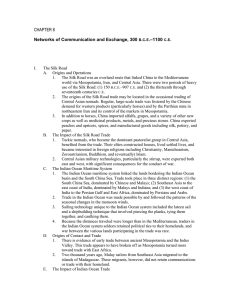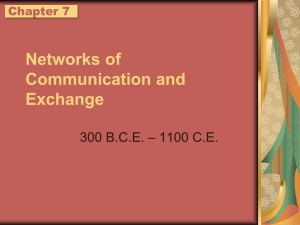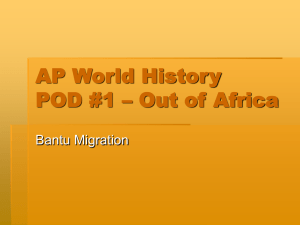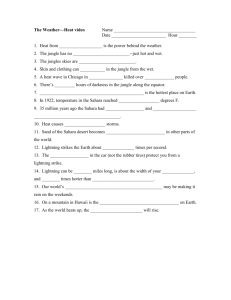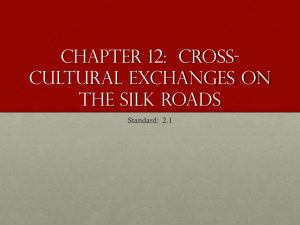Chapter 8 Notes Outline
advertisement
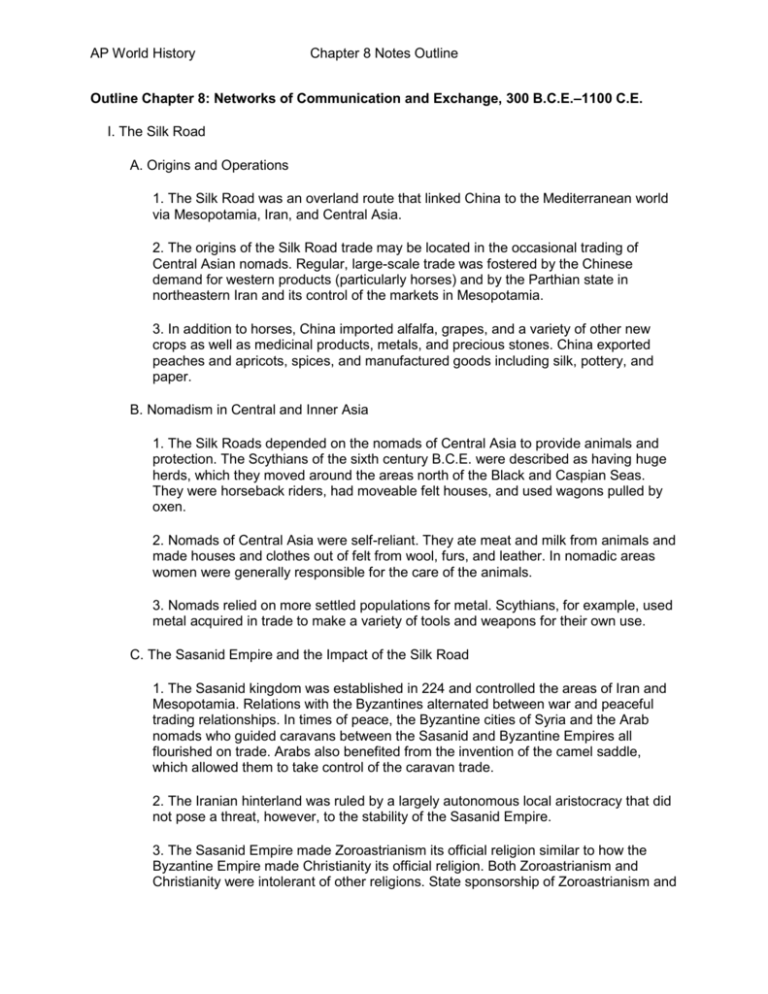
AP World History Chapter 8 Notes Outline Outline Chapter 8: Networks of Communication and Exchange, 300 B.C.E.–1100 C.E. I. The Silk Road A. Origins and Operations 1. The Silk Road was an overland route that linked China to the Mediterranean world via Mesopotamia, Iran, and Central Asia. 2. The origins of the Silk Road trade may be located in the occasional trading of Central Asian nomads. Regular, large-scale trade was fostered by the Chinese demand for western products (particularly horses) and by the Parthian state in northeastern Iran and its control of the markets in Mesopotamia. 3. In addition to horses, China imported alfalfa, grapes, and a variety of other new crops as well as medicinal products, metals, and precious stones. China exported peaches and apricots, spices, and manufactured goods including silk, pottery, and paper. B. Nomadism in Central and Inner Asia 1. The Silk Roads depended on the nomads of Central Asia to provide animals and protection. The Scythians of the sixth century B.C.E. were described as having huge herds, which they moved around the areas north of the Black and Caspian Seas. They were horseback riders, had moveable felt houses, and used wagons pulled by oxen. 2. Nomads of Central Asia were self-reliant. They ate meat and milk from animals and made houses and clothes out of felt from wool, furs, and leather. In nomadic areas women were generally responsible for the care of the animals. 3. Nomads relied on more settled populations for metal. Scythians, for example, used metal acquired in trade to make a variety of tools and weapons for their own use. C. The Sasanid Empire and the Impact of the Silk Road 1. The Sasanid kingdom was established in 224 and controlled the areas of Iran and Mesopotamia. Relations with the Byzantines alternated between war and peaceful trading relationships. In times of peace, the Byzantine cities of Syria and the Arab nomads who guided caravans between the Sasanid and Byzantine Empires all flourished on trade. Arabs also benefited from the invention of the camel saddle, which allowed them to take control of the caravan trade. 2. The Iranian hinterland was ruled by a largely autonomous local aristocracy that did not pose a threat, however, to the stability of the Sasanid Empire. 3. The Sasanid Empire made Zoroastrianism its official religion similar to how the Byzantine Empire made Christianity its official religion. Both Zoroastrianism and Christianity were intolerant of other religions. State sponsorship of Zoroastrianism and AP World History Chapter 8 Notes Outline Christianity set a precedent for the link that developed between the Islamic religion and the Islamic state. 4. The Byzantine and Sasanid empires were characterized by state involvement in theological struggles. In the third century, Mani of Mesopotamia founded a religion whose beliefs centered around the struggle between good and evil. Mani was killed by the Sasanid shah, but Manichaeism spread widely in Central Asia. Arabs had some awareness of these religious conflicts and knew about Christianity. 5. During this period, religion had replaced citizenship, language, and ethnicity as the paramount factor in people’s identity. 6. Turkic nomads, who became the dominant pastoralist group in Central Asia, benefited from the trade. Their elites constructed houses, lived settled lives, and became interested in foreign religions including Christianity, Manicheanism, Zoroastrianism, Buddhism, and (eventually) Islam. 7. Central Asian military technologies, particularly the stirrup, were exported both east and west, with significant consequences for the conduct of war. II. The Indian Ocean Maritime System A. Origins of Contact and Trade 1. There is evidence of early trade between ancient Mesopotamia and the Indus Valley. This trade appears to have broken off because Mesopotamia turned more toward trade with East Africa. 2. Two thousand years ago, Malay sailors from Southeast Asia migrated to the islands of Madagascar. These migrants, however, did not retain communications or trade with their homeland. B. The Impact of Indian Ocean Trade 1. What little we know about trade in the Indian Ocean system before Islam is gleaned largely from a single first century C.E. Greco-Egyptian text, The Periplus of the Erythrean Sea. This account describes a trading system that must have been well established and flourishing when the account was written. The goods traded included a wide variety of spices, aromatic resins, pearls, Chinese pottery, and other luxury goods. The volume of trade was probably not as high as in the Mediterranean. 2. The culture of the Indian Ocean ports was often isolated from that of their hinterlands. In the western part of the Indian Ocean, trading ports did not have access to large inland populations of potential consumers. Even in those eastern Indian and Malay peninsula ports that did have access to large inland populations, the civilizations did not become oriented toward the sea. 3. Traders and sailors in the Indian Ocean system often married local women in the ports that they frequented. These women thus became mediators between cultures. AP World History Chapter 8 Notes Outline III. Routes Across the Sahara A. Early Saharan Cultures 1. Undateable rock paintings in the highland areas that separate the southern from the northern Sahara indicate the existence of an early Saharan hunting culture that was later joined by cattle breeders who are portrayed as looking rather like contemporary West Africans. 2. The artwork indicates that the cattle breeders were later succeeded by horse herders who drove chariots. There is no evidence to support the earlier theory that these charioteers might have been Minoan or Mycenaean refugees. But there is also no evidence to show us either their origins or their fate. 3. The highland rock art indicates that camel riders followed the charioteers. The camel was introduced from Arabia, and its introduction and domestication in the Sahara was probably related to the development of the trans-Saharan trade. Written evidence and the design of camel saddles and patterns of camel use indicate a southto-north diffusion of camel riding. 4. The camel made it possible for people from the southern highlands of the Sahara to roam the desert and to establish contacts with the people of the northern Sahara. B. Trade Across the Sahara 1. Trade across the Sahara developed slowly when two local trading systems, one in the southern Sahara and one in the north, were linked. Traders in the southern Sahara had access to desert salt deposits and exported salt to the sub-Saharan regions in return for kola nuts and palm oil. 2. Roman colonists in the north exported agricultural products to Italy. In the third century C.E. transitions in with the decline of Rome, such as slowing trade, the abandonment of farms, and the growth of nomadism altered the connection that had existed before. IV. Sub-Saharan Africa A. A Challenging Geography 1. Sub-Saharan Africa is a large area with many different environmental zones and many geographical obstacles to movement. 2. Some of the significant geographical areas are the Sahel, the tropical savanna, the tropical rain forest of the lower Niger and Zaire, the savanna area south of the rain forest, steppe and desert below that, and the temperate highlands of South Africa. B. The Development of Cultural Unity AP World History Chapter 8 Notes Outline 1. Scholars draw a distinction between the “great traditions” of ruling elite culture in a civilization and the many “small traditions” of the common people. 2. In sub-Saharan Africa, no overarching great tradition developed. Sub-Saharan Africa is a vast territory of many small traditions. Historians know very little about the prehistory of these many small traditions and their peoples. 3. African cultures are highly diverse. The estimated two thousand spoken languages of the continent and the numerous different food production systems reflect the diversity of the African ecology and the difficulty of communication and trade between different groups. Another reason for the long dominance of small traditions is that no foreign power was able to conquer Africa and thus impose a unified great tradition. C. African Cultural Characteristics 1. Despite their diversity, African cultures display certain common features that attest to an underlying cultural unity. 2. One of these common cultural features is a concept of kingship in which kings are ritually isolated and oversee societies in which the people are arranged in age groups and kinship divisions. 3. Other common features include cultivation with the hoe and digging stick, the use of rhythm in African music, and the functions of dancing and mask wearing in rituals. 4. One hypothesis offered to explain this cultural unity holds that the people of subSaharan Africa are descended from the people who occupied the southern Sahara during its wet period and migrated south to the Sahel, where their cultural traditions developed. D. The Advent of Iron and the Bantu Migrations 1. Sub-Saharan agriculture had its origins north of the equator and then spread southward. Iron working also began north of the equator and spread southward. 2. Linguistic evidence suggests that the spread of iron and other technology in subSaharan Africa was the result of a phenomenon known as the Bantu migrations. 3. The original homeland of the Bantu people was in the area on the border of modern Nigeria and Cameroon. Evidence suggests that the Bantu people spread out toward the east and the south through a series of migrations over the period of the first millennium C.E. V. The Spread of Ideas A. Ideas and Material Evidence 1. It is extremely difficult, sometimes impossible, to trace the dissemination of ideas in preliterate societies. For example, eating pork was restricted or prohibited by religious AP World History Chapter 8 Notes Outline belief in Southeast Asia, in ancient Egypt, and in eastern Iran. Because Southeast Asia was an early center of pig domestication, scholars hypothesize that the pig and the religious injunctions concerning eating the pig traveled together toward the west. This has not been proved. 2. Another difficult problem involves the invention of coins. In the Mediterranean world, the coins were invented in Anatolia and spread from there to Europe, North Africa, and India. Chinese made cast copper coins—was this inspired by the Anatolian example? There is no way of knowing. B. The Spread of Buddhism 1. The spread of ideas in a deliberate and organized fashion such that we can trace it is a phenomenon of the first millennium C.E. This is particularly the case with the spread of Buddhism, Christianity, and Islam. 2. The spread of Buddhism was facilitated both by royal sponsorship and by the travels of ordinary pilgrims and missionaries. In India, the Mauryan king Ashoka and King Kanishka of the Kushans actively supported Buddhism. Two of the most wellknown pilgrims who helped to transmit Buddhism to China were the Chinese monks Faxian and Xuanzang. Both have left reliable narrative accounts of their journeys. 3. Buddhist missionaries from India traveled to a variety of destinations: west to Syria, Egypt, and Mesopotamia, as well as to Sri Lanka, Southeast Asia, and Tibet. 4. Buddhism was changed and further developed in the lands to which it spread. Theravada Buddhism became dominant in Sri Lanka, Mahayana in Tibet, and Chan (Zen) in East Asia. C. The Spread of Christianity 1. Armenia was an important entrepôt for the Silk Road trade. Mediterranean states spread Christianity to Armenia to bring that kingdom over to its side and thus deprive Iran of control of this area. 2. The transmission of Christianity to Ethiopia was similarly linked to a Mediterranean Christian attempt to deprive Iran of trade.


